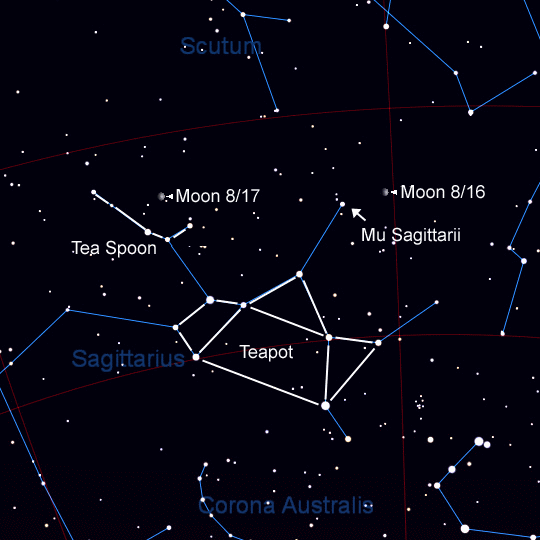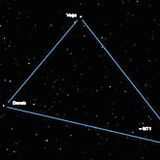
August 16
Tonight the Moon is in Sagittarius, The Archer, just under three degrees west of the fine double star Mu Sagittarii. The Moon is 10-1/2 days old and in waxing gibbous phase, on its way to full on the 20th. Here are some beautiful lunar targets to look for, as well as an interesting star system.
 Crater Hippalius
Crater HippaliusHippalus - This crater will be well placed tonight along the terminator, on the sunward side of Mare Humorum. You'll enjoy the craterlets, hills, damaged wall, and the Rimae Hippalus along the crater's eastern extremity. A 50mm instrument will allow you to see all of these features.
 Dome Mulichius
Dome MulichiusDome Mulichius - Use a telescope or pair of binoculars of 100mm or more to find this isolated circular-shaped volcanic dome. Can you see its summit crater? You'll find Dome Mulichius on the eastern part of Oceanus Procellarum, and in prime viewing postion (right along the terminator)tonight. For targets such as this, contrast is key! You will certainly also enjoy the fine view of the great crater Copernicus to the east.
 Mu Sagittarii and the Moon
Mu Sagittarii and the MoonMu Sagittari (Polis) - This magnitude 3.8 multiple star system is over 3,000 light years from Earth. Its A component (Polis) is 23 solar radii, has 115 times our sun's mass, and sports four companions. The B, C, D and E components are all within 50 arc-seconds and range in magnitude from 3.84 to 13.5. Can you find it with the Moon so close? Here is a chart to help you with this challenge.
August 17
The Moon will appear tonight as if cupped in the Tea Spoon asterism of Sagittarius, as shown above. Let's explore some more lunar features, then try a star hop.
 Gassendi and Doppelmayer, to the North and South of Mare humorum, respectively.
Gassendi and Doppelmayer, to the North and South of Mare humorum, respectively.Gassendi is on the northern edge of Mare Humorum, and this crater is replete with spectacular features. You will want to return to it over and over. The craters Gassendi A and B define the northern edge, with A breaking the walls of the main crater. A nice rubble field will appear between these and the terminator, and you're certain to see astounding detail. The main crater has high walls and steep outer slopes to the north, disappearing in the south. Interior, the floor is very flat and covered by the fractured landscape of Rima Gassendi, a mountainous inner ring, and a fine double-peaked, 1200-meter-high central mountain. There is so much to see in Gassendi!
Doppelmayeris a circular crater 39 miles in diameter, at an elevation of 8,200 feet on the lunar landscape. It defines the southern edge of the Mare Humorum, and is overrun on its northeastern perimeter by lava from the Mare. Its high walls will be in stark contrast tonight, as they are on the terminator side of the crater. You may even see shadows of the wall's peaks on the crater's floor. Additional features include a flat northern and disrupted southern floor, as well as a notable central mountain. Your 50 mm telescope or mounted binoculars will show it all!
 Zeta Aquarii
Zeta AquariiZeta Aquarii - Modern observers know this star as the center of the Mercedes symbol (an asterism). At magnitude 3.6, it is far enough from tonight's Moon to allow us to easily locate it. And this is a worthwhile find. Both components are yellow-white and appear nearly identical. The primary shines at magnitude 4.4, while the companion is magnitude 4.5. They comprise a close pair, but an easy split with a separation of 3.8 arc-seconds. Interestingly, this double star was directly on the celestial equator in 2004. Before then, it was a southern hemisphere star, now it is in the northern sky. It is an easy star hop from "The Moon In The Spoon" across to the bright pair in western Capricornus, through the line of bright stars in Aquarius, leading to the area containing Zeta Aquarii.
Lunar photos courtesy of The Lunar and Planetary Society. Charts from Starry Night Pro.
Mark Wagner is a life-long astronomy enthusiast and deep sky observer. He has spent the past twenty years popularizing amateur astronomy in the San Francisco bay area through his writing and community building. A past president of the San Jose Astronomical Association, he founded what is now the annual Golden State Star Party in California. Please post if you have comments, questions, sketches or images you've taken of the targets mentioned above.





















